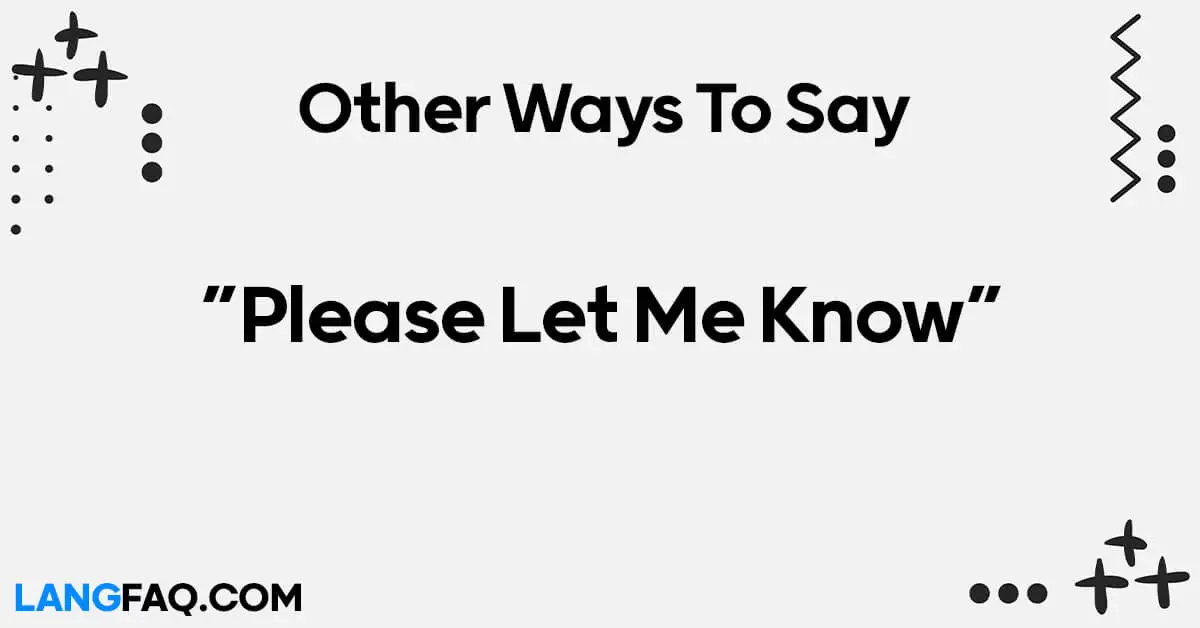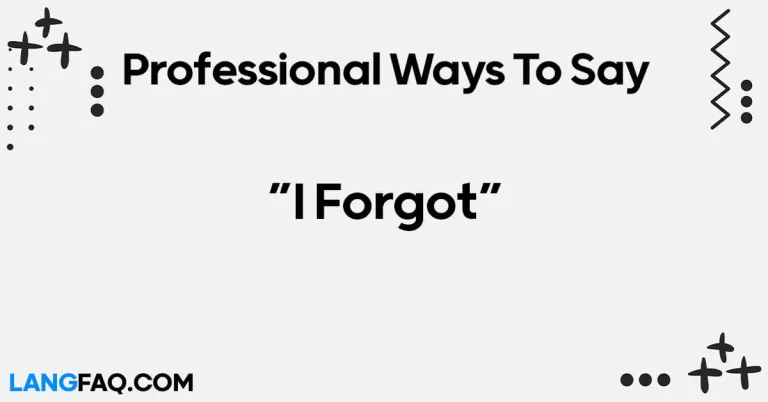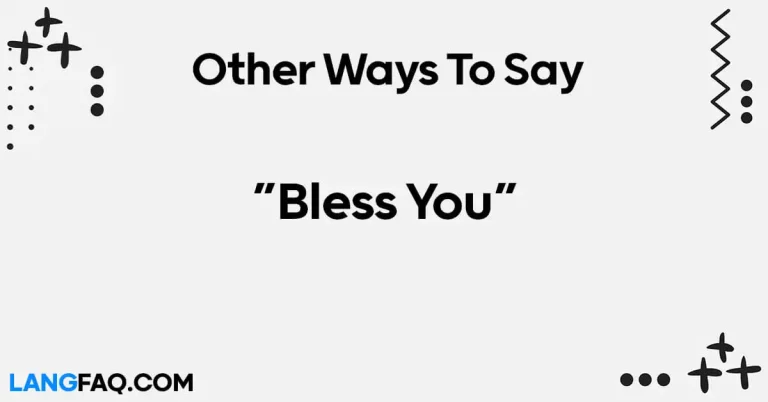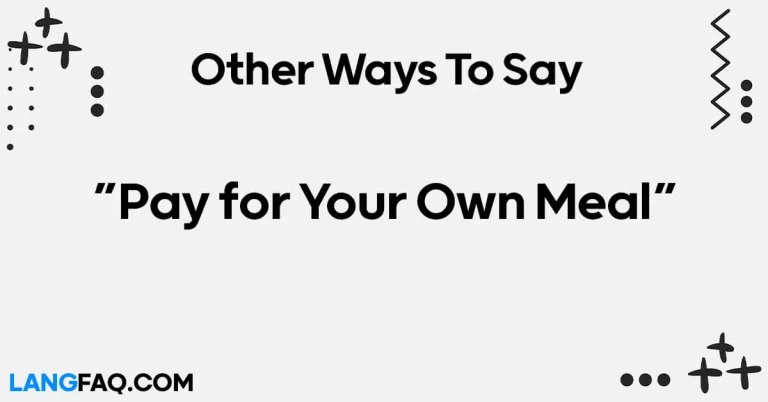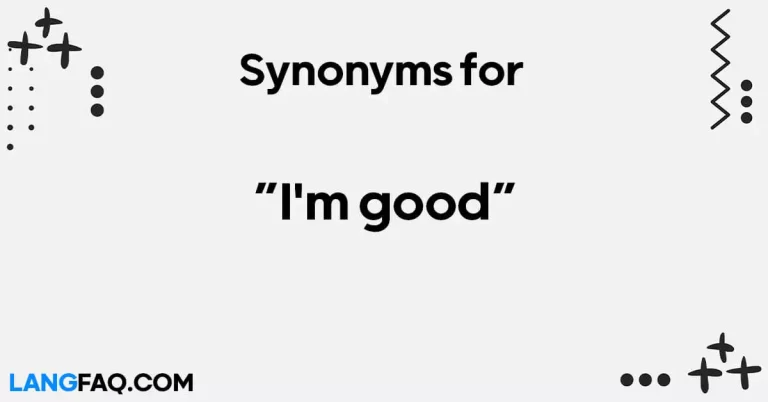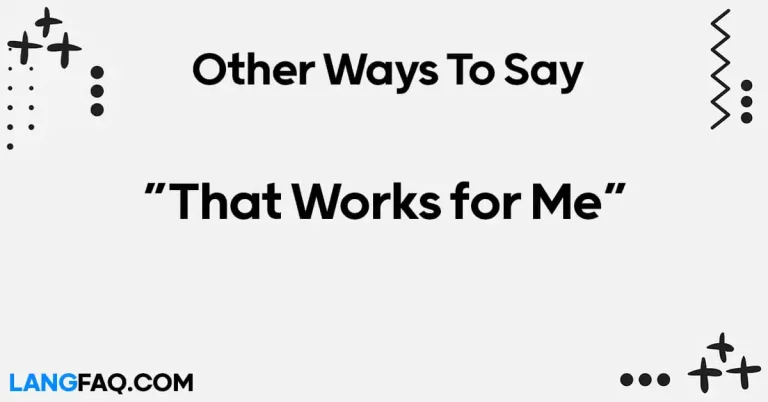Communication is a fundamental aspect of our daily lives, and finding diverse ways to express ourselves is crucial. In this comprehensive guide, we’ll delve into 12 Other Ways to Say “Please Let Me Know.” Enhance your language skills and add flair to your expressions with these engaging alternatives.
12 Other Ways to Say “Please Let Me Know”
Here are 12 other ways to express “Please let me know” in English:
- Kindly inform me.
- Keep me posted.
- Share your thoughts.
- I’d appreciate an update.
- Feel free to update me.
- Keep me in the loop.
- Drop me a line.
- Notify me at your earliest convenience.
- I’m eager to hear from you.
- Keep me abreast of the situation.
- I await your response.
- Don’t hesitate to reach out.
Here’s a table with meanings and examples for the 12 different ways to say “Please let me know”:
| Expression | Meaning | Example |
|---|---|---|
| Kindly inform me | Polite request for information | “Could you kindly inform me about the meeting details?” |
| Keep me posted | Request for ongoing updates | “Please keep me posted on the project’s progress.” |
| Share your thoughts | Encouragement to express opinions | “Feel free to share your thoughts on the matter.” |
| I’d appreciate an update | Polite way to request information | “I’d appreciate an update on the current situation.” |
| Feel free to update me | Invitation for providing information | “Feel free to update me whenever there’s news.” |
| Keep me in the loop | Request to be included in communication loop | “Make sure to keep me in the loop on project changes.” |
| Drop me a line | Informal request for a brief message | “Feel free to drop me a line if you have any questions.” |
| Notify me at your earliest convenience | Polite request for a timely update | “Could you please notify me at your earliest convenience?” |
| I’m eager to hear from you | Expressing anticipation for communication | “I’m eager to hear from you regarding the proposal.” |
| Keep me abreast of the situation | Request for continuous awareness | “Please keep me abreast of the situation as it develops.” |
| I await your response | Formal way to express waiting for a reply | “I await your response to the inquiry.” |
| Don’t hesitate to reach out | Encouragement to initiate communication | “Don’t hesitate to reach out if you need any clarification.” |
Having a diverse range of expressions to convey the request for information adds richness to our communication. These alternatives offer various levels of formality and nuances, allowing us to tailor our language to different situations and audiences.
Is It Correct to Say “Please Let Me Know”?
Absolutely, it is entirely correct to say “Please let me know.” This phrase is a polite and commonly used way to request information, seek clarification, or express interest in staying informed about a particular matter. It is versatile and appropriate for both formal and informal situations.
Example Scenarios:
- Formal Setting:
- In a professional email: “Could you please review the report and let me know your feedback by Friday?”
- During a business meeting: “If there are any updates on the project, please let me know during the briefing.”
- Informal Setting:
- Among friends making plans: “I’m not sure about my schedule yet. Let me check, and I’ll let you know.”
- Discussing weekend plans with family: “Are you available for a family gathering on Sunday? Please let me know.”
Variations:
- “Inform me, please.”
- “Keep me updated, if you can.”
- “Could you give me the details?”
Grammar/Usage Insights:
- The phrase is grammatically correct and commonly used in both written and spoken English.
- It’s considered polite and shows a respectful tone in communication.
Tips:
- Use this phrase when you want to request information or updates politely.
- It’s a versatile expression suitable for various contexts.
Professional Mail Example With “Please Let Me Know”
Subject: Follow-Up on Project Timeline
Dear [Recipient’s Name],
I trust this email finds you well. I am reaching out to inquire about the current status of our ongoing project, particularly regarding the upcoming milestone deadlines.
As we approach the critical phase of implementation, it would be immensely helpful to receive an update on the progress made thus far. Could you please review the project timeline and provide any insights into potential adjustments or challenges that may have arisen?
Your expertise and input are highly valued in ensuring the success of this project. If there are any concerns or if additional resources are required, please let me know at your earliest convenience. Additionally, if you foresee any impact on the established deadlines, it would be beneficial to discuss potential mitigation strategies.
I understand the demands on your time and appreciate your attention to this matter. Your timely response will not only assist in keeping the project on track but also contribute to our collective success.
Thank you for your dedication and efforts.
Best regards,
[Your Full Name] [Your Position] [Your Company] [Contact Information]
1. Kindly Inform Me
In both formal and informal contexts, “Kindly inform me” is a courteous and professional way to request information. This phrase is suitable for professional settings, especially when interacting with colleagues, clients, or superiors. It conveys a sense of politeness and respect.
Example Scenario: Imagine you are working on a collaborative project, and you need an update from a team member. In a professional email, you might write, “Kindly inform me of the current status of the project by the end of the day.”
Email Sample:
Subject: Project Update Request
Dear [Recipient’s Name],
I hope this message finds you well. Could you kindly inform me of the current status of the project? I appreciate your prompt attention to this matter.
Best regards, [Your Name]
Variations:
- “Please keep me informed about any developments.”
- “I would appreciate it if you could provide me with updates regularly.”
Pros:
- Polite and formal.
- Suitable for professional communication.
Cons:
- May sound a bit formal in casual settings.
2. Keep Me Posted
“Keep me posted” is a versatile expression suitable for various situations, both formal and informal. It is commonly used when you want to stay informed about ongoing developments. This phrase is perfect for interactions with colleagues, friends, or family members.
Example Scenario: You are planning a surprise birthday party for a friend, and you’ve assigned tasks to different people. In a casual conversation, you might say, “Hey, keep me posted on how the decorations are coming along.”
Email Sample:
Subject: Party Planning Update
Hi [Friend’s Name],
I hope you’re doing well. Just a quick check-in – could you keep me posted on how the party planning is going? Looking forward to the celebration!
Cheers, [Your Name]
Variations:
- “Let me know how things progress.”
- “Keep me in the loop about any changes.”
Pros:
- Informal and friendly.
- Suitable for various relationships and settings.
Cons:
- May be considered too casual in very formal contexts.
3. Share Your Thoughts
“Share your thoughts” is an encouraging phrase used to invite opinions or perspectives. It is applicable in both formal and informal settings, fostering open communication and collaboration.
Example Scenario: During a team meeting, you might say, “Before we finalize the proposal, I’d like everyone to share their thoughts on the budget allocation.”
Email Sample:
Subject: Input Needed for Proposal
Hi Team,
As we approach the finalization of the proposal, I encourage each of you to share your thoughts on the budget allocation. Your input is highly valued.
Best, [Your Name]
Variations:
- “I’m interested in hearing your perspective.”
- “Feel free to express your ideas on this matter.”
Pros:
- Encourages open communication.
- Demonstrates a collaborative approach.
Cons:
- May require a supportive team culture for full effectiveness.
4. I’d Appreciate an Update
This phrase is a polite way to request information and is suitable for formal and professional contexts. It conveys a sense of respect for the recipient’s time and effort.
Example Scenario: In a business context, you might say, “I’d appreciate an update on the sales figures for the last quarter by the end of this week.”
Email Sample:
Subject: Request for Sales Figures Update
Dear [Recipient’s Name],
I trust this email finds you well. I’d appreciate an update on the sales figures for the last quarter by the end of this week. Thank you for your prompt attention to this matter.
Sincerely, [Your Name]
Variations:
- “Could you provide me with the latest information?”
- “Your update on this matter would be highly valued.”
Pros:
- Polite and formal.
- Clearly expresses the need for information.
Cons:
- May be perceived as somewhat formal in casual settings.
5. Feel Free to Update Me
“Feel free to update me” strikes a balance between formality and friendliness. It is suitable for various contexts, making it a versatile phrase for both professional and informal communication.
Example Scenario: In a team project, you might say, “As we work on individual tasks, feel free to update me on your progress anytime.”
Email Sample:
Subject: Project Update Availability
Hi [Team Member’s Name],
I hope you’re doing well. As we dive into our respective tasks, feel free to update me on your progress whenever you find it convenient. Collaboration is key!
Best regards, [Your Name]
Variations:
- “Keep me in the loop about your progress.”
- “I’m open to updates whenever you have them.”
Pros:
- Strikes a balance between formality and friendliness.
- Invites open communication.
Cons:
- May sound slightly informal in very formal settings.
6. Keep Me in the Loop
“Keep me in the loop” is a casual yet effective way to express the desire to stay informed. It is suitable for both professional and informal situations, emphasizing the importance of continuous communication.
Example Scenario: In a business project, you might say, “As we move forward with the client, let’s make sure to keep everyone in the loop about any changes in requirements.”
Email Sample:
Subject: Project Collaboration – Keeping in the Loop
Hi Team,
As we progress with our collaboration on the client project, let’s make a collective effort to keep everyone in the loop about any changes in requirements. This ensures smooth teamwork.
Cheers, [Your Name]
Variations:
- “I want to be aware of any updates in the project.”
- “Please ensure I’m kept informed about changes.”
Pros:
- Emphasizes the importance of continuous communication.
- Suitable for various relationships.
Cons:
- May be considered too casual in highly formal settings.
7. Drop Me a Line
“Drop me a line” is an informal and friendly way to encourage communication. It’s suitable for both professional and personal contexts, adding a touch of approachability to your request for information.
Example Scenario: In a work setting, you might say, “If you come across any challenges, feel free to drop me a line, and we can discuss how to address them.”
Email Sample:
Subject: Open Communication
Hi [Colleague’s Name],
Hope you’re having a great day! Just a quick note – if you come across any challenges or have ideas to share, feel free to drop me a line. Let’s keep the communication flowing.
Best, [Your Name]
Variations:
- “Reach out to me whenever you need assistance.”
- “I’m just a line away if you have any questions.”
Pros:
- Informal and friendly.
- Encourages open dialogue.
Cons:
- May not be suitable for very formal communication.
8. Notify Me at Your Earliest Convenience
This phrase is a formal and polite way to request timely updates. It is suitable for professional contexts where a sense of urgency is required.
Example Scenario: In a business project, you might say, “Please review the document and notify me at your earliest convenience if any revisions are needed.”
Email Sample:
Subject: Document Review Request
Dear [Recipient’s Name],
I trust this email finds you well. Could you please review the attached document at your earliest convenience? Notify me if any revisions are needed. Thank you for your prompt attention to this matter.
Sincerely, [Your Name]
Variations:
- “I appreciate your timely notifications.”
- “Your prompt updates are highly valued.”
Pros:
- Formal and respectful.
- Clearly expresses the need for timely updates.
Cons:
- May sound too formal in casual settings.
9. I’m Eager to Hear from You
Expressing eagerness to hear from someone adds a personal touch to your request. This phrase is versatile and can be used in both formal and informal contexts.
Example Scenario: In a business negotiation, you might say, “As we finalize the terms, I’m eager to hear from you about any additional considerations.”
Email Sample:
Subject: Further Discussion on Terms
Dear [Recipient’s Name],
I hope this message finds you well. As we work towards finalizing the terms, I’m eager to hear from you about any additional considerations you may have. Your input is crucial to the success of our collaboration.
Best regards, [Your Name]
Variations:
- “Looking forward to your insights on this matter.”
- “Your thoughts are eagerly awaited.”
Pros:
- Adds a personal touch to your request.
- Suitable for various relationships.
Cons:
- May sound too informal in highly formal settings.
10. Keep Me Abreast of the Situation
“Keep me abreast of the situation” is a formal way to request continuous awareness. It’s suitable for professional contexts where staying informed is crucial.
Example Scenario: In a project management role, you might say, “As we navigate through potential challenges, please keep me abreast of the situation so that we can make informed decisions.”
Email Sample:
Subject: Continuous Updates on Project Status
Hi [Team],
As we navigate through the various phases of the project, I kindly request each team member to keep me abreast of the situation. This ensures that we can collectively make informed decisions. Your cooperation is appreciated.
Best regards, [Your Name]
Variations:
- “I need to be kept informed about any changes.”
- “Continuous updates are crucial for our success.”
Pros:
- Formal and emphasizes the importance of staying informed.
- Suitable for professional communication.
Cons:
- May sound too formal in casual settings.
11. I Await Your Response
This phrase is a formal way to express waiting for a reply. It is suitable for professional contexts where a sense of formality is required.
Example Scenario: In a business negotiation, you might say, “After reviewing the proposal, I await your response on the proposed terms and conditions.”
Email Sample:
Subject: Proposal Review – Awaiting Your Response
Dear [Recipient’s Name],
I trust this email finds you well. After thorough review of the proposal, I await your response on the proposed terms and conditions. Your timely feedback is crucial for the next steps in our collaboration.
Sincerely, [Your Name]
Variations:
- “Your response is eagerly anticipated.”
- “I look forward to hearing from you.”
Pros:
- Formal and expresses a sense of anticipation.
- Suitable for professional communication.
Cons:
- May sound too formal in casual settings.
12. Don’t Hesitate to Reach Out
This phrase is an encouraging way to invite communication. It is suitable for both professional and personal contexts, creating an open and approachable atmosphere.
Example Scenario: In a mentor-mentee relationship, a mentor might say, “As you work on your projects, don’t hesitate to reach out if you need guidance or have any questions.”
Email Sample:
Subject: Open Communication Channel
Hi [Mentee’s Name],
Hope your projects are going well! Just a quick note – as you navigate through them, don’t hesitate to reach out if you need any guidance or have questions. I’m here to support you.
Best, [Mentor’s Name]
Variations:
- “Feel free to contact me if you require assistance.”
- “I’m here for you, so don’t hesitate to ask for help.”
Pros:
- Encourages open communication.
- Suitable for mentor-mentee or supportive relationships.
Cons:
- May not be suitable for very formal communication.
Frequently Asked Questions (FAQs)
Q: Are these alternatives suitable for formal and informal settings? Absolutely! These alternatives can be adapted to various settings, maintaining both formality and informality.
Q: How can I remember these alternatives in the heat of a conversation? Practice is key. Gradually incorporate these phrases into your daily communication to make them second nature.
Q: Can I use these alternatives in written communication as well? Certainly! Whether spoken or written, these alternatives add a touch of variety to your language.
Q: Are these alternatives universally understood? Yes, these alternatives are widely understood and can be used in diverse cultural and linguistic contexts.
Q: Will using these alternatives make me sound more professional? Indeed! Employing varied language shows versatility and can enhance your professional communication.
Q: Can I mix and match these alternatives in a single conversation? Absolutely! Feel free to combine these alternatives to suit the context and flow of your conversation.
Conclusion
Diversify your language and elevate your communication skills with these 12 Other Ways to Say “Please Let Me Know.” From seeking information to expressing curiosity, these alternatives offer a spectrum of possibilities. Incorporate them into your daily conversations and watch your communication flourish.

